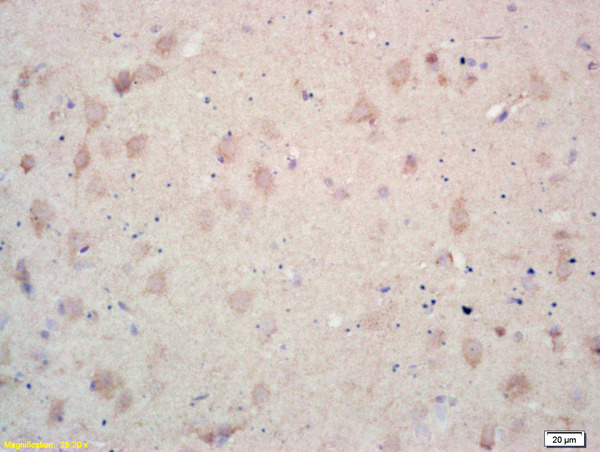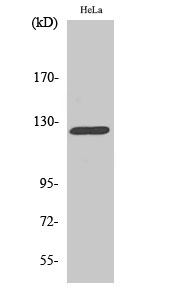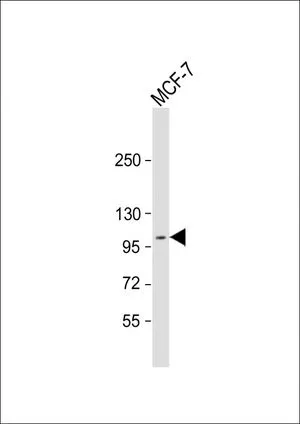DDR1 antibody [N1N3]
GTX111453
ApplicationsWestern Blot, ImmunoHistoChemistry, ImmunoHistoChemistry Paraffin
Product group Antibodies
ReactivityHuman, Mouse
TargetDDR1
Overview
- SupplierGeneTex
- Product NameDDR1 antibody [N1N3]
- Delivery Days Customer9
- Application Supplier NoteWB: 1:1000-1:10000. IHC-P: 1:100-1:1000. *Optimal dilutions/concentrations should be determined by the researcher.Not tested in other applications.
- ApplicationsWestern Blot, ImmunoHistoChemistry, ImmunoHistoChemistry Paraffin
- CertificationResearch Use Only
- ClonalityPolyclonal
- Concentration0.69 mg/ml
- ConjugateUnconjugated
- Gene ID780
- Target nameDDR1
- Target descriptiondiscoidin domain receptor tyrosine kinase 1
- Target synonymsCAK, CD167, DDR, EDDR1, HGK2, MCK10, NEP, NTRK4, PTK3, PTK3A, RTK6, TRKE, epithelial discoidin domain-containing receptor 1, CD167 antigen-like family member A, PTK3A protein tyrosine kinase 3A, cell adhesion kinase, mammary carcinoma kinase 10, neuroepithelial tyrosine kinase, neurotrophic tyrosine kinase, receptor, type 4, protein-tyrosine kinase RTK-6, tyrosine kinase DDR, tyrosine-protein kinase CAK
- HostRabbit
- IsotypeIgG
- Protein IDQ08345
- Protein NameEpithelial discoidin domain-containing receptor 1
- Scientific DescriptionReceptor tyrosine kinases (RTKs) play a key role in the communication of cells with their microenvironment. These molecules are involved in the regulation of cell growth, differentiation and metabolism. The protein encoded by this gene is a RTK that is widely expressed in normal and transformed epithelial cells and is activated by various types of collagen. This protein belongs to a subfamily of tyrosine kinase receptors with a homology region to the Dictyostelium discoideum protein discoidin I in their extracellular domain. Its autophosphorylation is achieved by all collagens so far tested (type I to type VI). In situ studies and Northern-blot analysis showed that expression of this encoded protein is restricted to epithelial cells, particularly in the kidney, lung, gastrointestinal tract, and brain. In addition, this protein is significantly over-expressed in several human tumors from breast, ovarian, esophageal, and pediatric brain. This gene is located on chromosome 6p21.3 in proximity to several HLA class I genes. Alternative splicing of this gene results in multiple transcript variants. [provided by RefSeq]
- ReactivityHuman, Mouse
- Storage Instruction-20°C or -80°C,2°C to 8°C
- UNSPSC12352203
References
- Min S, Lee YK, Hong J, et al. MRPS31 loss is a key driver of mitochondrial deregulation and hepatocellular carcinoma aggressiveness. Cell Death Dis. 2021,12(11):1076. doi: 10.1038/s41419-021-04370-8Read this paper
- Romayor I, Márquez J, Benedicto A, et al. Tumor DDR1 deficiency reduces liver metastasis by colon carcinoma and impairs stromal reaction. Am J Physiol Gastrointest Liver Physiol. 2021,320(6):G1002-G1013. doi: 10.1152/ajpgi.00078.2021Read this paper
- Okada J, Yamada E, Saito T, et al. Dapagliflozin Inhibits Cell Adhesion to Collagen I and IV and Increases Ectodomain Proteolytic Cleavage of DDR1 by Increasing ADAM10 Activity. Molecules. 2020,25(3). doi: 10.3390/molecules25030495Read this paper
- Oefner CM, Sharkey A, Gardner L, et al. Collagen type IV at the fetal-maternal interface. Placenta. 2015,36(1):59-68. doi: 10.1016/j.placenta.2014.10.012Read this paper






